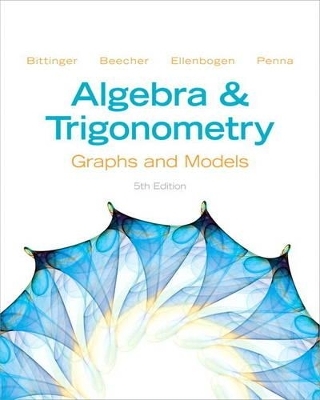
Algebra and Trigonometry
Pearson
978-0-321-84447-7 (ISBN)
- Titel erscheint in neuer Auflage
- Artikel merken
Packages
Access codes for Pearson's MyLab & Mastering products may not be included when purchasing or renting from companies other than Pearson; check with the seller before completing your purchase.
Used or rental books
If you rent or purchase a used book with an access code, the access code may have been redeemed previously and you may have to purchase a new access code.
Access codes
Access codes that are purchased from sellers other than Pearson carry a higher risk of being either the wrong ISBN or a previously redeemed code. Check with the seller prior to purchase.
--
The Graphs and Models series by Bittinger, Beecher, Ellenbogen, and Penna is known for helping students “see the math” through its focus on visualization and technology. These texts continue to maintain the features that have helped students succeed for years: focus on functions, visual emphasis, side-by-side algebraic and graphical solutions, and real-data applications.
With the Fifth Edition, visualization is taken to a new level with technology. The authors also integrate smartphone apps, encouraging readers to visualize the math. In addition, ongoing review has been added with new Mid-Chapter Mixed Review exercise sets and new Study Guide summaries to help students prepare for tests.
Marvin Bittinger has been teaching math at the university level for more than thirty-eight years. Since 1968, he has been employed at Indiana University–Purdue University Indianapolis, and is now professor emeritus of mathematics education. Professor Bittinger has authored over 190 publications on topics ranging from basic mathematics to algebra and trigonometry to applied calculus. He received his BA in mathematics from Manchester College and his PhD in mathematics education from Purdue University. Special honors include Distinguished Visiting Professor at the United States Air Force Academy and his election to the Manchester College Board of Trustees from 1992 to 1999. His hobbies include hiking in Utah, baseball, golf, and bowling. Professor Bittinger has also had the privilege of speaking at many mathematics conventions, most recently giving a lecture entitled "Baseball and Mathematics." In addition, he also has an interest in philosophy and theology, in particular, apologetics. Professor Bittinger currently lives in Carmel, Indiana with his wife, Elaine. He has two grown and married sons, Lowell and Chris, and four granddaughters. Judy Beecher has an undergraduate degree in mathematics from Indiana University and a graduate degree in mathematics from Purdue University. She has taught at both the high school and college levels with many years of developmental math and precalculus teaching experience at Indiana University–Purdue University Indianapolis. In addition to her career in textbook publishing, she spends time traveling, enjoying her grandchildren, and promoting charity projects for a children's camp. David Ellenbogen has taught math at the college level for twenty-two years, spending most of that time in the Massachusetts and Vermont community college systems, where he has served on both curriculum and developmental math committees. He has also taught at St. Michael's College and The University of Vermont. Professor Ellenbogen has been active in the Mathematical Association of Two Year Colleges since 1985, having served on its Developmental Mathematics Committee and as a delegate, and has been a member of the Mathematical Association of America since 1979. He has authored dozens of publications on topics ranging from prealgebra to calculus and has delivered lectures at numerous conferences on the use of language in mathematics. Professor Ellenbogen received his BA in mathematics from Bates College and his MA in community college mathematics education from The University of Massachusetts at Amherst. A co-founder of the Colchester Vermont Recycling Program, Professor Ellenbogen has a deep love for the environment and the outdoors, especially in his home state of Vermont. In his spare time, he enjoys playing keyboard in the band Soularium, volunteering as a community mentor, hiking, biking, and skiing. He has two sons, Monroe and Zack. Judy Penna received her undergraduate degree in mathematics from Kansas State University and her graduate degree in mathematics from the University of Illinois. Since then, she has taught at Indiana University–Purdue University Indianapolis and at Butler University, and continues to focus on writing quality textbooks for undergraduate mathematics students. In her free time she likes to travel, read, knit, and spend time with her children.
Preface
Guide to Success
R. Basic Concepts of Algebra
R.1 The Real-Number System
R.2 Integer Exponents, Scientific Notation, and Order of Operations
R.3 Addition, Subtraction, and Multiplication of Polynomials
R.4 Factoring
R.5 The Basics of Equation Solving
R.6 Rational Expressions
R.7 Radical Notation and Rational Exponents
1. Graphs, Functions, and Models
1.1 Introduction to Graphing
1.2 Functions and Graphs
1.3 Linear Functions, Slope, and Applications
1.4 Equations of Lines and Modeling
1.5 Linear Equations, Functions, Zeros, and Applications
1.6 Solving Linear Inequalities
2. More on Functions
2.1 Increasing, Decreasing, and Piecewise Functions; Applications
2.2 The Algebra of Functions
2.3 The Composition of Functions
2.4 Symmetry
2.5 Transformations
2.6 Variation and Applications
3. Quadratic Functions and Equations; Inequalities
3.1 The Complex Numbers
3.2 Quadratic Equations, Functions, Zeros, and Models
3.3 Analyzing Graphs of Quadratic Functions
3.4 Solving Rational Equations and Radical Equations
3.5 Solving Equations and Inequalities with Absolute Value
4. Polynomial and Rational Functions
4.1 Polynomial Functions and Modeling
4.2 Graphing Polynomial Functions
4.3 Polynomial Division; The Remainder Theorem and the Factor Theorem
4.4 Theorems about Zeros of Polynomial Functions
4.5 Rational Functions
4.6 Polynomial Inequalities and Rational Inequalities
5. Exponential and Logarithmic Functions
5.1 Inverse Functions
5.2 Exponential Functions and Graphs
5.3 Logarithmic Functions and Graphs
5.4 Properties of Logarithmic Functions
5.5 Solving Exponential and Logarithmic Equations
5.6 Applications and Models: Growth and Decay; Compound Interest
6. The Trigonometric Functions
6.1 Trigonometric Functions of Acute Angles
6.2 Applications of Right Triangles
6.3 Trigonometric Functions of Any Angle
6.4 Radians, Arc Length, and Angular Speed
6.5 Circular Functions: Graphs and Properties
6.6 Graphs of Transformed Sine and Cosine Functions
7. Trigonometric Identities, Inverse Functions, and Equations
7.1 Identities: Pythagorean and Sum and Difference
7.2 Identities: Cofunction, Double-Angle, and Half-Angle
7.3 Proving Trigonometric Identities
7.4 Inverses of the Trigonometric Functions
7.5 Solving Trigonometric Equations
8. Applications of Trigonometry
8.1 The Law of Sines
8.2 The Law of Cosines
8.3 Complex Numbers: Trigonometric Form
8.4 Polar Coordinates and Graphs
8.5 Vectors and Applications
8.6 Vector Operations
9. Systems of Equations and Matrices
9.1 Systems of Equations in Two Variables
9.2 Systems of Equations in Three Variables
9.3 Matrices and Systems of Equations
9.4 Matrix Operations
9.5 Inverses of Matrices
9.6 Determinants and Cramer's Rule
9.7 Systems of Inequalities and Linear Programming
9.8 Partial Fractions
10. Analytic Geometry Topics
10.1 The Parabola
10.2 The Circle and the Ellipse
10.3 The Hyperbola
10.4 Nonlinear Systems of Equations and Inequalities
10.5 Rotation of Axes
10.6 Polar Equations of Conics
10.7 Parametric Equations
11. Sequences, Series, and Combinatorics
11.1 Sequences and Series
11.2 Arithmetic Sequences and Series
11.3 Geometric Sequences and Series
11.4 Mathematical Induction
11.5 Combinatorics: Permutations
11.6 Combinatorics: Combinations
11.7 The Binomial Theorem
11.8 Probability
Photo Credits
Answers
Index of Applications
Index
| Erscheint lt. Verlag | 4.3.2013 |
|---|---|
| Sprache | englisch |
| Gewicht | 2245 g |
| Themenwelt | Mathematik / Informatik ► Mathematik ► Algebra |
| Mathematik / Informatik ► Mathematik ► Geometrie / Topologie | |
| ISBN-10 | 0-321-84447-5 / 0321844475 |
| ISBN-13 | 978-0-321-84447-7 / 9780321844477 |
| Zustand | Neuware |
| Informationen gemäß Produktsicherheitsverordnung (GPSR) | |
| Haben Sie eine Frage zum Produkt? |
aus dem Bereich

